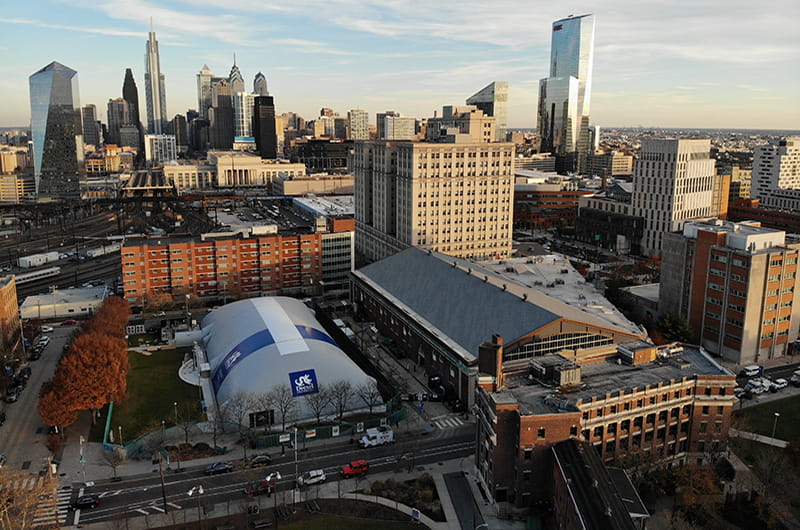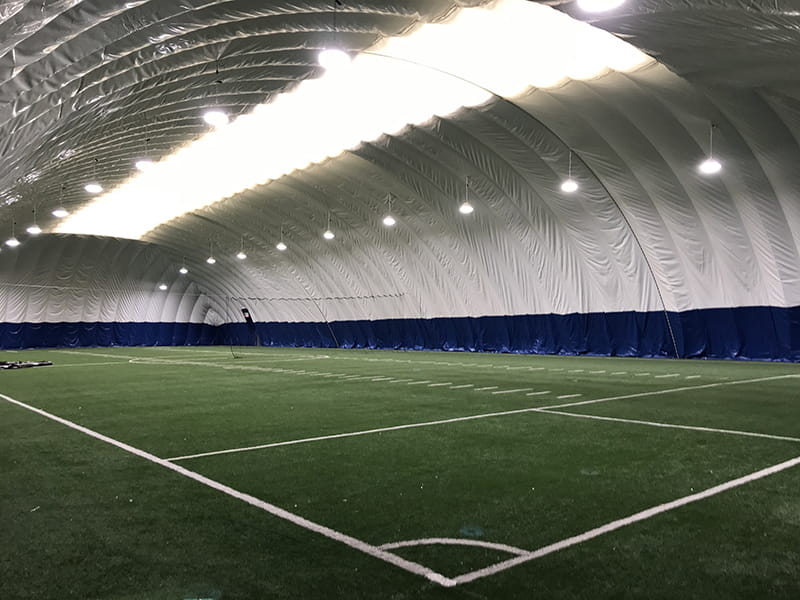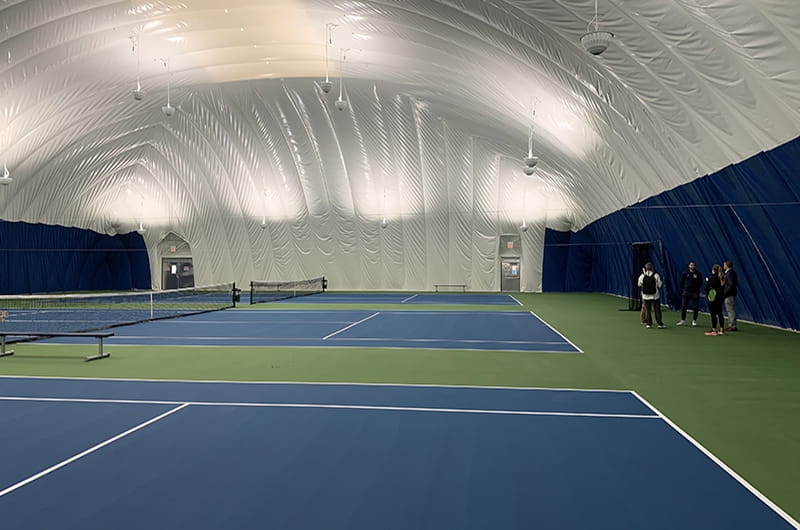Athletic Bubbles Inflated to Improve Athletic Programming

If you’ve recently visited or even walked near Drexel University’s Vidas Athletic Complex or Buckley Recreational Field, then you’ve probably seen the “bubbles.”
These massive, stark white dome structures are now inflated over the tennis courts at the Vidas Athletic Complex and the turf field at Buckley Field — and they are pretty hard to miss. But why, exactly, are they there?
In this Q&A, Director of Athletics and Carl R. Pacifico Professor of Neuropsychology Eric Zillmer, PsyD, discussed how the bubbles will benefit the Drexel community, when they will be used and what student teams can practice and play inside.
Q: Why were these bubbles installed? Is this the first time that Drexel has installed these kinds of bubbles?
A: The Drexel sport bubbles, or air-supported structures, are a historic first for the University. The bubbles provide an annual, seasonal opportunity for Drexel Athletics to extend its sports outdoor season at Vidas Athletic Complex and Buckley Recreational Field. In each case, a foundation had to be built to accommodate the supportive bubble infrastructure. And, in each scenario, the bubbles had to be designed over an existing sports performance area. In the case of Buckley Recreational Field, this was a multi-purpose filled-in turf, and in the case of the Vidas Athletic Complex, over tennis courts. This provides us with some flexibility in athletic programming in terms of having both indoor “soft” turf and hard surfaces.
In my opinion, it is essential for Drexel, which is known as a great comprehensive urban university, to provide our students with rich athletic performance opportunities for teamwork, socializing, fun, competition and fitness. With the Armory being re-purposed for a state-of-the-art national squash center, Drexel Athletics has made it a priority to make targeted enhancements to facilities that can catalyze significant growth in our recreational, intramural, club and varsity programming. The two bubbles are a key part to this initiative.

Q: When are they officially going to be opened?
A: The bubbles are being installed and the final touches, lighting, security cameras, etc., are being finished right now. The Vidas Bubble was the first to be installed and I received reports and pictures of tennis usage as of today (Nov. 26). The Buckley Bubble is up as well, and we plan to have it be operating by Dec. 2 for limited hours. Since this our first time assembling bubbles and managing them, we are planning for the spaces to be open for usage in December but be fully operational in January when our students return to school.
Q: How will these bubbles benefit Drexel athletes?
A: Athletics is playing an increasingly visible and important role in the perception and life of this institution’s reputation as a leading private comprehensive research university. Today, more than 450 Drexel student-athletes compete in 18 varsity sports; 1,400 students compete in 34 intercollegiate club sports; and two out of three students participate in intramural competition. In total, more than 700,000 Drexel students, alumni, faculty, staff and community members use the Daskalakis Athletic Center (DAC) for recreational programming every year.
Recreational activity for students has become an integral part of our campus, which is motivated by the modern student’s expectations to engage in a healthy lifestyle and to be part of a community — a neighborhood within Drexel. In addition, usage of recreational facilities is associated with higher retention rates as well as higher SAT and GPA scores. That is, Drexel Athletics partnered with Drexel’s Office of Planning and Institutional Research to study the relationship between retention and DAC usage. We found increased retention and GPAs in Drexel first-year students who use the DAC more than 10 times a year. Managing your well-being through sports, competition and recreation is healthy for the body and the mind. Our Drexel students know this intuitively and we have over 3,000 students visit the DAC per day during the academic quarter. The bubbles will allow us to increase our sports season and provide additional sports programming.
Q: Besides that, are there other benefits of these bubbles?
A: The bubbles provide protection in the winter months from inclement weather. Specifically, they protect from rain, snow, wind and cold temperature, and extend the day through artificial lighting. Bubbles are typically 10 to 20 degrees warmer inside and the modern LED lighting allows for perfect sports playing condition. Our bubbles have a transparent roof and thus there is also natural light coming into the bubbles during daytime hours.

The biggest reason, in my opinion, for acquiring bubbles, however, is psychological. Once you enter the “safety” of the enclosed space of a bubble, you want to just play — throw a frisbee, serve a tennis ball, kick a soccer ball. It is such an interesting space and one of our biggest enclosed spaces on campus. The Vidas and Buckley bubbles are almost 20,000 and 30,000 square feet, respectively.
I have been Drexel’s athletics director for the past 21 years and I would have to say that, besides the opening of the Rec Center 10 years ago, the addition of these two bubbles are a paradigm shift for the University in terms of providing safe access for our students to engage in physical activity. This is consistent with the landscape of athletics across the nation and the region. For example, Princeton University and Loyola University in Baltimore just opened bubbles as well. In fact, several local educational institutions have inquired about our bubbles once they learned about it.
Q: Who can use these bubbles? What teams/organizations?
A: The bubbles are open for play for the Drexel community. We will also provide programming space for ROTC. You will need a student ID to enter if you are a student or be a member of the DAC if you are faculty or professional staff. There will be open rec play as well as scheduled programming for intramurals, club and varsity teams. Our intramural program has become very popular over the last 10 years. For example, soccer and flag football intramurals have had over 100 teams participate in the past and we offer men, women and co-ed leagues. We also have competitive club teams, such as tennis, rugby and even Quidditch, all of which will benefit from the bubbles. Intramurals and club teams are open to all students. Varsity teams, like softball, will use the bubbles for practice during the winter months.
Q: Will there be stands or seating inside the bubbles?
A: The bubbles are big enough to accommodate some sideline viewing for spectators, but stands and seating are not included. The bubbles are meant mostly for recreational use.
Q: Are the bubbles going to be up year-round? Are they going to be installed every year or just this year?
A: By law, temporary structures like the bubbles are only allowed to be in usage for up to 180 days. So, they will be only implemented annually during winter months at Drexel. Every fall, the two bubbles will be “inflated” and ready for use by our Drexel community. In the spring, when the weather becomes warmer, they will be taken down and stored remotely.
Q: Can you talk about the technical aspects of the bubbles? What is the material made out of? How will they be maintained, especially during inclement weather like snowstorms?

A: The technology regarding bubbles has come a long way since these domes were originally conceptualized at an expo in the 1970s in Japan. The bubbles are inflated, and a constant positive air pressure is kept inside to give them the dome-like shape. Just like a tire, the air pressure in a dome keeps the walls up. For a dome, these forces are relatively small, so the inside air pressure only needs to be slightly higher than the outside pressure. But one has to enter and exit through airlocks, which is most easily done by using a revolving door. The constant air pressure is provided by fans, which also provide some heating so that snow would melt and not accumulate on the roof. Our managers will have mobile apps that will allow them to get data on internal air pressure and temperature among other information.
I believe that the bubbles fit seamlessly, in terms of their inherent technology and their design, with Drexel’s commitment to innovation and technology.
Q: Is there anything else you wanted to mention, or would want people to know?
A: First, I want to thank Jackie and Stan Silverman as well as Marlene and Bob Buckley for their friendship with Drexel Athletics and their leadership gifts towards the bubbles through the Campaign for Drexel. They have an amazing appetite for making Drexel a better place and ensuring that all of our students have a place to simply play. The Vidas and Buckley bubbles also represent cost-effective solutions to provide more sports opportunities for our Drexel students, with improved lighting, temperature and climate control.
Once the supporting infrastructure is in place, there is flexibility in terms of installing or taking down an air dome on annual basis. The idea is to convert to indoor facilities for the winter and switch back to outdoor fields and courts for the summer. The spaces inside a bubble can also be used for different sports purposes. Unlike other types of construction, our bubbles create massive clean spaces that aren’t obstructed by things like supporting walls or poles. For example, the dome-covered Buckley field could be used for any number of field sports including football, lacrosse, soccer or even dodgeball.
Finally, the Drexel bubbles are simply cool. They look impressive and stepping inside of a bubble for the first time is an experience in and of itself. It seems counterintuitive to see such a large indoor space in an urban setting. Go Dragons!
According to Drexel Recreational Athletics, the Buckley Bubble will be open Dec. 2–Dec. 6 from 5–9 p.m., Dec. 7 from 12–4 p.m. and Dec. 9–Dec. 13 from 5–9 p.m.In This Article
Drexel News is produced by
University Marketing and Communications.

